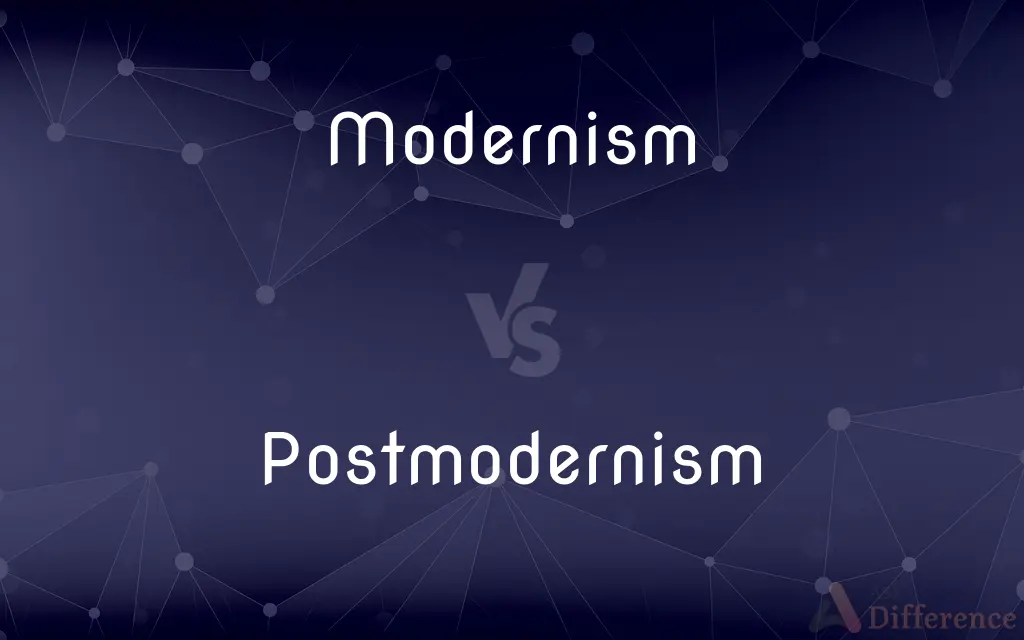Modernism vs. Postmodernism — What's the Difference?
By Maham Liaqat & Urooj Arif — Updated on March 24, 2024
Modernism seeks universal truth and order through art and narrative, while Postmodernism questions these very concepts, embracing ambiguity and diverse perspectives.

Difference Between Modernism and Postmodernism
Table of Contents
ADVERTISEMENT
Key Differences
Modernism, emerging in the late 19th and early 20th centuries, reflects a quest for an underlying truth and order in the chaos of the modern world. On the other hand, Postmodernism, rising in the mid-20th century, challenges the notion of universal truths and objective reality, arguing that these are constructs shaped by cultural, social, and personal contexts. Postmodern works are characterized by a skepticism of grand narratives and ideologies, an embrace of irony, and a playful mixing of styles and mediums.
Modernism tends to view technology and progress optimistically, seeing them as means to improve human life and understanding. In contrast, Postmodernism often adopts a more critical stance toward technology and progress, highlighting the ways in which these forces can alienate, oppress, or homogenize, questioning the very notion of "improvement" or progress itself.
The narrative structure in Modernism is typically coherent and linear, aiming to reflect the complexity of reality through fragmented or stream-of-consciousness techniques that still seek a cohesive understanding of the world. Postmodern narratives, however, deliberately embrace non-linearity, paradox, and fragmentation, suggesting that reality is too complex, contradictory, or subjective to be fully captured by any single narrative.
In Modernism, there's an emphasis on the author or creator as a singular source of meaning, offering a distinct perspective or vision through their work. Postmodernism, conversely, decentralizes the author's role, suggesting that meaning is created in the interaction between the text (or artwork) and the audience, and that multiple interpretations are not only possible but desirable.
Modernism and Postmodernism both engage with the idea of what it means to be human, but from different angles. Modernism often explores the depths of human consciousness and identity, seeking to uncover universal aspects of the human condition. Postmodernism, however, questions the very idea of a stable, unified identity, pointing out the fragmented, constructed nature of selfhood in a postmodern world.
ADVERTISEMENT
Comparison Chart
Time Period
Late 19th - Mid 20th Century
Mid 20th Century - Present
View on Truth
Seeks universal truths
Questions the existence of a singular truth
Narrative Structure
Linear, coherent
Non-linear, fragmented
Attitude towards Progress
Generally optimistic
Skeptical or critical
Role of Author/Creator
Central, authoritative
Decentralized, multiple meanings
Perception of Identity
Seeks a unified self
Views identity as fragmented and constructed
Compare with Definitions
Modernism
Linear Narratives.
Despite experimentation, modernist narratives tend towards coherence and unity.
Postmodernism
Postmodernism embraces non-linearity and fragmentation, reflecting the complexity of reality.
Death of the Author.
Modernism
Quest for Truth.
Modernism aims to uncover universal truths through innovative art and literature.
Postmodernism
Postmodernism challenges the existence of universal truths, emphasizing subjective realities.
Critique of Progress.
Modernism
Unified Self.
Modernist literature explores deep aspects of human consciousness, seeking a universal human essence.
Postmodernism
Postmodernism suggests that meaning is created by the reader, not fixed by the author.
Constructed Identity.
Modernism
Technological Optimism.
Modernist works often celebrate the potential of technology and progress to improve society.
Postmodernism
Postmodern literature portrays identity as fragmented and socially constructed, rather than fixed.
Modernism
Authorial Authority.
In Modernism, the author's intent and vision are considered paramount in interpreting a work.
Postmodernism
Postmodern works often critique the notion of progress, highlighting its potential downsides.
Fragmented Narratives.
Modernism
Modernism is both a philosophical movement and an art movement that arose from broad transformations in Western society during the late 19th and early 20th centuries. The movement reflected a desire for the creation of new forms of art, philosophy, and social organization which reflected the newly emerging industrial world, including features such as urbanization, new technologies, and war.
Postmodernism
Postmodernism is a broad movement that developed in the mid-to-late 20th century across philosophy, the arts, architecture, and criticism, marking a departure from modernism. The term has been more generally applied to describe a historical era said to follow after modernity and the tendencies of this era.
Modernism
Modern thought, character, or practice.
Postmodernism
Of or relating to art, architecture, or literature that reacts against earlier modernist principles, as by reintroducing traditional or classical elements of style or by carrying modernist styles or practices to extremes
"It [a roadhouse]is so architecturally interesting ... with its postmodern wooden booths and sculptural clock" (Ruth Reichl).
Modernism
Sympathy with or conformity to modern ideas, practices, or standards.
Postmodernism
Of or relating to an intellectual stance often marked by eclecticism and irony and tending to reject the universal validity of such principles as hierarchy, binary opposition, categorization, and stable identity.
Modernism
A peculiarity of usage or style, as of a word or phrase, that is characteristic of modern times.
Postmodernism
Any style in art, architecture, literature, philosophy, etc., that reacts against an earlier modernist movement.
Modernism
Often Modernism The deliberate departure from tradition and the use of innovative forms of expression that distinguish many styles in the arts and literature of the 1900s.
Postmodernism
An attitude of skepticism or irony toward modernist ideologies, often questioning the assumptions of Enlightenment rationality and rejecting the idea of objective truth.
Modernism
Often Modernism A Roman Catholic movement, officially condemned in 1907, that attempted to examine traditional belief according to contemporary philosophy, criticism, and historiography.
Postmodernism
Genre of art and literature and especially architecture in reaction against principles and practices of established modernism
Modernism
(uncountable) Modern or contemporary ideas, thought, practices, etc.
Modernism
(countable) Anything that is characteristic of modernity.
Modernism
Any of several styles of art, architecture, literature, philosophy, etc., that flourished in the 20th century.
Modernism
A religious movement in the early 20th century, condemned as heretical by Pope Pius X, which tried to reconcile Roman Catholic dogma with modern science and philosophy.
Modernism
Modern practice; a thing of recent date; esp., a modern usage or mode of expression.
Modernism
Certain methods and tendencies which, in Biblical questions, apologetics, and the theory of dogma, in the endeavor to reconcile the doctrines of the Roman Catholic Church with the conclusions of modern science, replace the authority of the church by purely subjective criteria; - so called officially by Pope Pius X.
Modernism
Genre of art and literature that makes a self-conscious break with previous genres
Modernism
The quality of being current or of the present;
A shopping mall would instill a spirit of modernity into this village
Modernism
Practices typical of contemporary life or thought
Common Curiosities
Why does Postmodernism critique progress?
Postmodernism critiques progress for its potential to marginalize, homogenize, and impose singular narratives, questioning its supposed benefits.
How does Postmodernism differ from Modernism?
Postmodernism rejects the quest for universal truths and coherent narratives, embracing ambiguity, fragmentation, and diverse perspectives.
What defines Modernism?
Modernism is an artistic movement emphasizing innovation, the pursuit of universal truths, and the power of human progress.
Is the author irrelevant in Postmodernism?
Not irrelevant, but the author's intent is considered one of many potential interpretations, rather than the definitive meaning of the work.
What role does irony play in Postmodernism?
Irony is often used in Postmodernism to challenge established norms, question authenticity, and undermine grand narratives.
Can a work be both Modernist and Postmodernist?
Some works may exhibit characteristics of both movements, especially those on the cusp of the historical transition, reflecting evolving attitudes.
What's the Postmodern view on cultural narratives?
Postmodernism sees cultural narratives as constructed and relative, promoting a multiplicity of viewpoints over a single dominant culture.
Do Modernism and Postmodernism share any similarities?
Both movements engage deeply with questions of meaning, reality, and the human condition, though their approaches and conclusions often diverge.
Can Modernist works be nonlinear?
Yes, Modernist works often experiment with form, including non-linear structures, but typically in the quest for deeper coherence or truth.
How do these movements influence architecture?
Modernist architecture emphasizes function, simplicity, and coherence, while Postmodern architecture embraces complexity, contradiction, and playful elements.
What's the significance of fragmented narratives in Postmodernism?
Fragmentation reflects the Postmodern belief in the multiplicity of perspectives and the complexity of reality, resisting singular interpretations.
How do Modernism and Postmodernism view technology?
Modernism generally sees technology as a tool for progress, whereas Postmodernism is more critical, questioning its impact on society and individuality.
How does Modernism approach the concept of identity?
Modernism seeks to explore and articulate a coherent, universal aspect of human identity through introspection and existential inquiry.
How does Postmodernism affect the arts?
Postmodernism has led to a diversification of artistic styles and practices, encouraging cross-disciplinary works and the blurring of genre boundaries.
What impact have these movements had on literature?
They've profoundly influenced narrative techniques, thematic exploration, and the role of the reader in constructing meaning, reshaping literary landscapes.
Share Your Discovery

Previous Comparison
Basher vs. Busher
Next Comparison
Crenation vs. HemolysisAuthor Spotlight
Written by
Maham LiaqatCo-written by
Urooj ArifUrooj is a skilled content writer at Ask Difference, known for her exceptional ability to simplify complex topics into engaging and informative content. With a passion for research and a flair for clear, concise writing, she consistently delivers articles that resonate with our diverse audience.














































